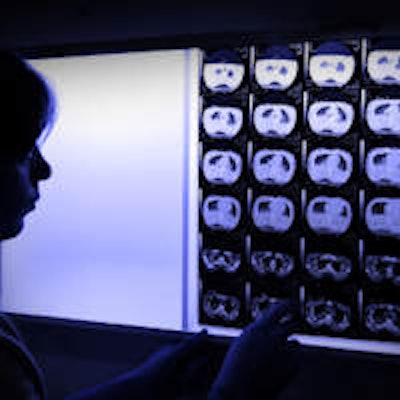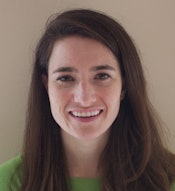
When it comes to educating patients about the daily duties of a radiologist, a few simple teaching tools can go a long way in clearing misconceptions about the profession and its contribution to everyday healthcare, according to a study presented at the recent American College of Radiology (ACR) meeting.
By taking advantage of a captive audience in the radiology waiting room, the staff at the University of Virginia (UVA) enlightened patients on what happens during a radiologist's workday. Among other nuggets of knowledge, they promoted the fact that, yes, a radiologist really is a doctor.
 Dr. Allison Lippert.
Dr. Allison Lippert."It is easy for us to become a commodity," said radiologist Dr. Allison Lippert, who led the study during her UVA fellowship. "One of the most important ways for us not to end up in that situation is to have patients who understand and advocate for us. If they don't understand the basics of being a radiologist, how can we expect them to appreciate what we do?"
Radiology's purpose
It's safe to say that a majority of patients are unfamiliar with the integral role radiology serves in healthcare. One contributing factor may be the advent of PACS, which arguably has made radiologists less visible to patients and referring physicians.
"I think because of PACS, we are not readily available to patients, with the exception of some subspecialties like interventional radiology," Lippert told AuntMinnie.com. "In order for patients to ask for services, like subspecialty reading that will give them more meaningful reports, they need to understand that we are doctors and we have specialty and subspecialty training."
To gauge the state of patient knowledge about radiology, Lippert and colleagues performed a prospective study at the University of Virginia Medical Center from November 2013 until July 2014. During that time, surveys were given to 477 patients in the main radiology waiting room.
The 16 questions were mostly multiple choice and dealt with knowledge about radiologists. Questions included the following:
- What is a radiologist? Potential answers: Technologist. Nurse. Doctor. Physician's assistant. Don't know.
- Who takes your images for your x-rays, CT scan, MRI, ultrasound, and/or mammograms? Potential answers: Technologist. Nurse. Doctor. Physician's assistant. Don't know.
- How many years of training are involved in becoming a radiologist?
- Who formally interprets your x-rays, ultrasound, CT, mammogram, or MRI? Potential answers: Surgeon. Family doctor/pediatrician/internal medicine doctor. Radiologist. Emergency room doctor. Don't know.
The medical center then created several informal PowerPoint presentations and other media describing the radiologist's role in healthcare for patients to view while in the waiting room.
"Our education campaign was fairly minimal, and I say that in a good way," Lippert added. "We made a few PowerPoint presentations, ran those in the waiting room, and had an almost life-sized poster of one of the radiologists with a description of what a radiologist does."
Pop quiz grades
After implementing the teaching tools, the same survey was distributed to 333 different patients from September 2015 to March 2016.
The pre-education and posteducation groups were matched for age and gender. Among the respondents, 271 (61%) in the pre-education group had at least a college degree, as did 180 respondents (59%) in the posteducation group.
When they compared the two sets of responses, the researchers found a higher percentage of correct answers among those patients who saw the educational materials.
| Effect of education program on patient knowledge of radiologists | |||
| Questions | Answer pre-education | Answer posteducation | p-value |
| A radiologist is a doctor | 175 (36.7%) | 156 (47.7%) | < 0.002 |
| A radiologist is a technologist | 267 (56%) | 161 (48.6) | < 0.001 |
| A radiologist takes images | 221 (46.3%) | 133 (40.2%) | 0.083 |
| A radiologist interprets images | 248 (52%) | 206 (62.2%) | 0.043 |
| A radiologist interprets images, as opposed to other physicians, family doctors, or surgeons | 285 (63.1%) | 204 (65.6%) | 0.490 |
While the numbers showed a significant improvement, a fair number of patients still had a somewhat limited and skewed concept of a radiologist's role in healthcare, Lippert and colleagues noted.
"The number of people who know we are doctors is still not near what we would want," she said. "It went from 37% to 48%, but that is still less than 50% of patients who know that radiologists are doctors. So you can see where we can stretch the efforts for patient education a lot further."
For Lippert, the study is personal. Both her father and brother-in-law are radiologists. She finished her radiology fellowship at the University of Virginia last year and spent the next nine months as a radiologist in the U.S. Veterans Health Administration.
"I grew up wanting to be a radiologist since I was 12 years old," she recalled. "I wanted to be in a field where I would do well, and we can't do well if we just sit there and read studies and do not interact with our referring physicians and help our patients."
Additional outreach
The researchers cited several limitations of the study, including its single academic institution scope, which means the results could vary at other facilities and with different patient populations. Also, the large portion of participants with at least a college degree could have affected the results.
In addition, some patients checked off more than one answer for questions requiring only a single response, and not all patients in the waiting room were given a survey.
"Given the discrepancy between our findings and the limited amount of research available on the topic, additional evaluation with larger populations and multicenter studies is warranted," the authors wrote in their abstract. "Further investigation could involve more extensive marketing and education campaigns, as ours was restricted to a single general radiology department waiting room."
"We still have a long way to go, but with some small changes, we were able to make one of those statistically significant changes in what our patients know about us," Lippert said. "I think we can take that to a larger marketing effort."



















